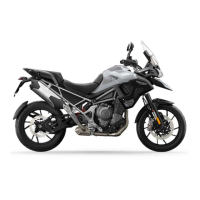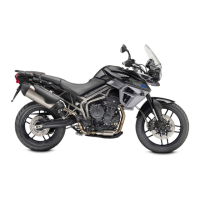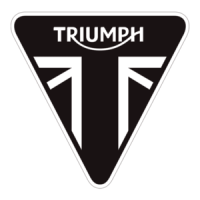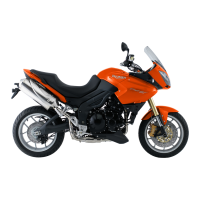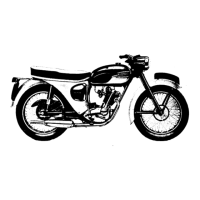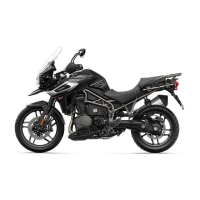
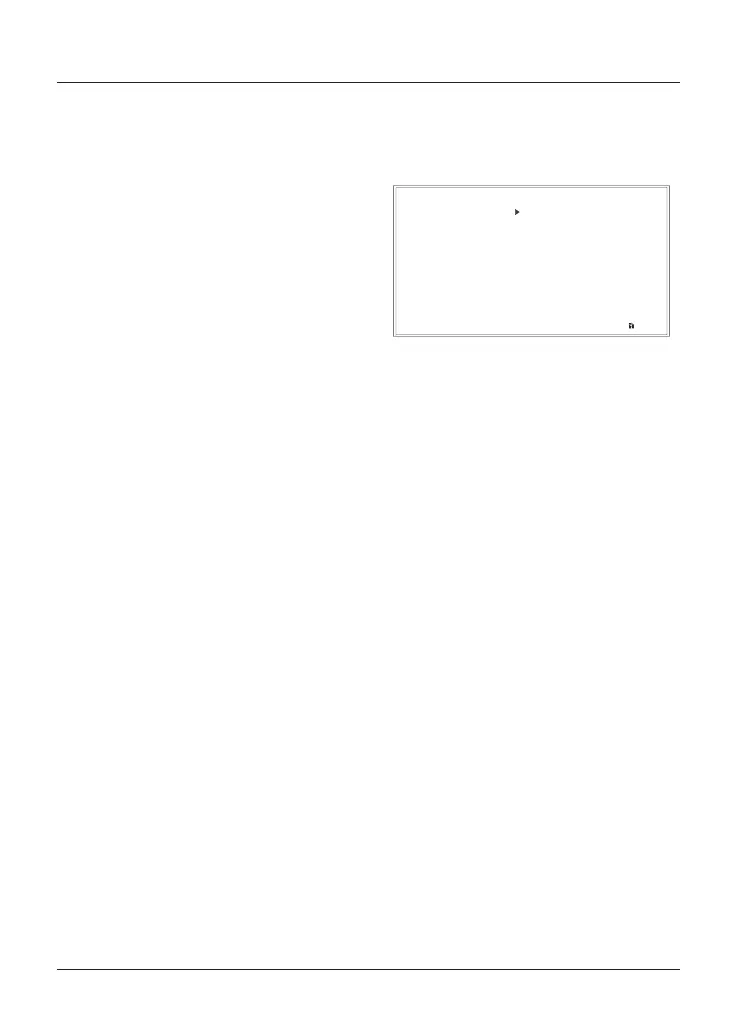 Loading...
Loading...
Do you have a question about the Triumph Tiger 1200 XR and is the answer not in the manual?
| Engine Type | Liquid-cooled, 12-valve, DOHC, inline 3-cylinder |
|---|---|
| Power | 141 PS (139 bhp) at 9, 250 rpm |
| Torque | 122 Nm @ 7, 600 rpm |
| Transmission | 6-speed |
| Fuel Capacity | 20 liters |
| Rear Suspension | Showa monoshock |
| Brakes | Rear: Single 282mm disc |
| Tires | Front: 120/70 R19; Rear: 170/60 R17 |
Explains symbols for warnings, cautions, and notes used in the handbook.
Advises on motorcycle maintenance by authorized dealers and provides contact information.
Discusses design for on-road/light off-road use and warns against extreme off-road use.
Warns about reduced cornering bank angles and ground clearance for LRH models.
Warns about gasoline flammability and hazards of exhaust fumes in enclosed spaces.
Advises on wearing protective gear, including DOT-approved helmets and bright clothing.
Warns against riding fatigued/under influence and stresses licensing and training.
Introduces labels detailing safety information and their relation to handbook content.
Illustrates label locations on the motorcycle with numbered references.
Provides a diagram and list of external motorcycle parts with numerical references.
Continues the diagram and list of external motorcycle parts with numerical references.
Identifies controls and instruments from the rider's perspective.
Explains the location of VIN and engine serial numbers for record-keeping.
Details VIN location stamped on the frame and on a label.
Specifies the engine serial number location stamped on the engine crankcase.
Mentions two types of instrument displays: TFT and LCD.
Lists items covered in the TFT instrument display section.
Details the TFT instrument display layout and its features.
Explains icons and buttons used for navigating instrument menus.
Explains the MIL light and its meaning for engine faults.
Details normal ABS light behavior and conditions for constant illumination.
Explains the fuel gauge operation, low fuel warning, and range display.
Introduces riding modes for adjusting throttle, ABS, and TC settings.
Covers various hand controls like levers, switches, and throttle.
Explains the ignition switch and steering lock mechanism.
Details the four ignition switch positions and key removal.
Identifies switches on the right handlebar.
Identifies switches on the left handlebar.
Explains the electronic throttle grip system and its operation.
Details adjustment of brake and clutch levers for comfort and ergonomics.
Introduces the cruise control system and its functions.
Details steps to turn on cruise control and activation conditions.
Explains the TSAS system for suspension adjustment.
Explains TC function in maintaining traction on slippery surfaces.
Explains the TPMS system and warns against excluding daily tire pressure checks.
Covers fuel requirements, octane ratings, and refueling.
Provides instructions for filling the fuel tank to prevent spillage.
Covers windshield cleaning and adjustment, with warnings.
Explains handlebar adjustment procedures and recommends dealer assistance.
Covers side stand and center stand usage and safety.
Covers seat removal, installation, and care.
Explains rider's seat height adjustment procedure and warnings.
Explains electrical accessory socket functions, locations, and power supply.
Details USB socket function, location, and charging capabilities.
Describes expedition aluminum panniers and their availability.
Provides guidelines for breaking in new motorcycles.
Lists daily checks for fuel, oil, tires, fasteners, steering, and brakes.
Details engine stopping procedures.
Details engine starting procedures.
Details procedures for moving off from a standstill.
Explains gear shifting procedures and warnings.
Covers braking system components and operation.
Explains ABS function in preventing wheel lock and maximizing braking effectiveness.
Explains optimized cornering ABS function and its limitations.
Explains Hill Hold Control function for hill starts and its operation.
Covers safe parking procedures and warnings.
Discusses factors for high-speed operation and associated risks.
Discusses how accessories and weight affect handling, stability, and speed.
Warns against installing accessories that impair control or visibility.
Warns about exceeding pannier/top box load limits and risks of instability.
Warns that incorrect loading may result in unsafe conditions and loss of control.
Discusses how passenger presence affects handling and braking.
Emphasizes the importance of maintenance and warns against incorrect procedures.
A detailed table outlining maintenance tasks and intervals.
Details engine oil inspection, change, and disposal.
Covers coolant level inspection, adjustment, and change.
Covers steering and wheel bearing inspection.
Details front fork inspection and adjustment.
Details rear suspension adjustment.
Covers tire inflation pressures, wear, and replacement.
Covers battery type, rating, charging, and maintenance.
Explains fuse box locations and fuse identification.
Details precautions to take before washing, such as covering specific areas.
Provides instructions for washing the motorcycle using mild cleaner.
Provides care instructions for matt paintwork.
Covers cleaning of chrome and stainless steel parts.
Details cleaning procedures for exhaust systems.
Covers windshield cleaning procedures, warning against abrasive products.
Provides care instructions for leather products.
Details steps for preparing the motorcycle for storage.
Lists model-specific dimensions, weights, and performance figures.
Lists maximum payload capacities for different Tiger 1200 models.
Details engine type, displacement, bore/stroke, and compression ratio.
Specifies lubrication type and engine oil capacities.
Details fuel system type, injectors, fuel pump, and pressure.
Details transmission type, clutch type, final drive ratio, and gear ratios.
Lists approved tires and warns against mixing manufacturers or specifications.
Specifies tire pressures (cold), tire sizes, and electrical equipment details.
Lists tightening torques for various components.
